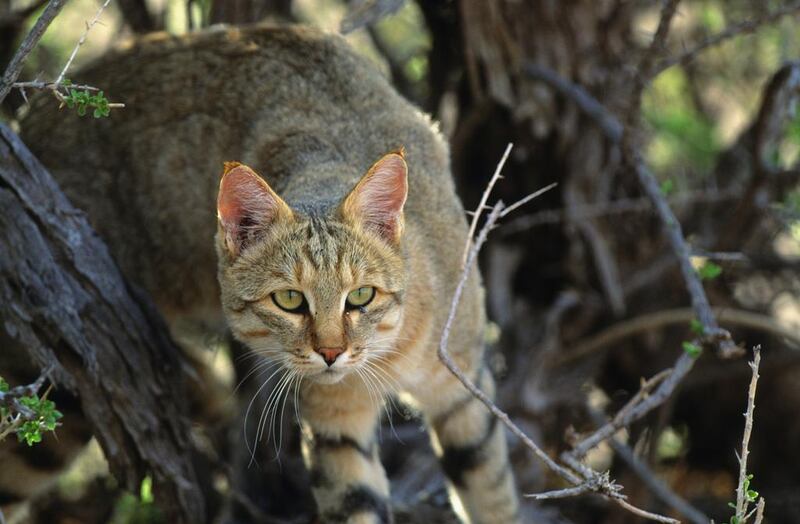With their big eyes, plaintive miaows and friendly purr, cats have been favourite pets for thousands of years, and there are now believed to be as many as 600 million domestic cats globally.
They are a common sight in the UAE, which is appropriate given that domestic cats are believed to have originated in the Middle East, making those seen wandering the streets here more at home than they realise.
A landmark study in 2007 on the genetics of hundreds of cats found that domestic cats worldwide, which have the Latin name Felis silvestris catus, had close links with the Arabian wildcat, Felis silvestris lybica.
So domestic cats in, for example, Europe were more similar genetically to the Arabian wildcat than to the European wildcat.
Including an analysis of Arabian wildcats collected in Bahrain and the UAE, the research indicated that the region’s wildcats “represent the ancestral founder population of domestic cats supporting a domestication origin” in the Middle East.
The Fertile Crescent, which covers parts of what are now Iraq, Syria, Egypt and other countries, is believed to be where, about 10,000 years ago, cat domestication was taking place.
It is not thought to have happened intentionally, unlike with dogs. Instead, wildcats were attracted to the vermin that lived around grain stores created after the development of agriculture, and there was natural selection for cats willing to interact with people: humans were not choosing particular felines to breed.
"Cats are unique among domesticates in that they were domesticated by natural selection rather than artificial selection," said Dr Carlos Driscoll, senior author of the 2007 study, published in Science.
“That brilliant observation is not mine but [Charles] Darwin’s. Darwin recognised that cats don’t have any utility. Without selective breeding you cannot have artificial selection.”
Narrowing down the origin of the domestic cat more precisely than the Fertile Crescent will probably not be possible, according to Dr John Bradshaw, author of a recent bestselling book on cat origins and behaviour, Cat Sense.
“According to their DNA there was no single event, but rather a gradual evolution from wild to semi-domestic over a period of thousands of years,” he said.
“Thus the two genomes separated gradually, with interbreeding between the two diminishing gradually, all over the Middle East.”
There are parallels with how, in modern times, urban foxes in European cities such as London have become less wary of human beings, again because of natural selection.
“Humans are providing the environment and animals are making use of that,” said Dr Driscoll, a fellow at the section on comparative behavioural genomics at the National Institutes of Health, in Maryland, United States.
Bringing the cat domestication story up to date, Dr Driscoll has co-authored a major study into feline genetics published a few months ago in the Proceedings of the National Academy of Sciences.
By comparing the genomes of domestic cats with those of wildcats, other types of cat, dogs, cows and humans, the researchers found that cats have particular genes that affect their ability to digest fats. This is thought to be because they are “obligate” carnivores, meaning they have to eat meat.
Also, domestic cats showed differences with wildcats when it came to genes that affect fear behaviour and how the animals respond to rewards. “Our findings are only hypotheses at this point that are in need of further testing,” said Dr Michael Montague, senior author of the PNAS paper and a postdoctoral researcher at Washington University School of Medicine.
“But, if you had to make an educated guess as to which genes would be different between the two types of cat populations [domestic and wild], you might suspect that genes involved with neurotransmitter receptors or brain biology and development would distinguish a tame house cat from a wild animal.”
This ties in with the view of Dr Bradshaw, a visiting fellow and director of the Anthrozoology Institute at the University of Bristol in the United Kingdom, that the key difference between wildcats and domestic cats is the way the latter will “accept socialisation to humans”.
“There must be a genetic basis for this, presumably in the timing of the development of certain parts of the brain,” he said.
Dr Montague and his fellow researchers are now working to improve the detail of their database of cat genomes.
They are obtaining genetic information from a greater array of domestic cat breeds and wildcats.
“We hope these efforts will also contribute to the veterinary sciences through an increased awareness of the genetic components responsible for inherited components that impact cat health and disease,” Dr Montague said.
Dr Driscoll, who has collected blood samples from wildcats in Bahrain, is now looking for more genetic variation between wild and domestic cats.
“We will be able to use this to compare more fully against the domestic cat, and hopefully pull out more of the genes that are different between them,” he said.
So scientists are set to uncover more genetic secrets of the domestic cat, an animal that has kept people in the Middle East company for thousands of years.
newsdesk@thenational.ae







